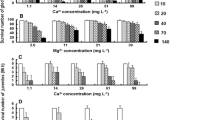Abstract
The brine shrimp Artemia salina L. was acclimated in sea water with cupric chloride, acetate, carbonate, and sulphate, each at concentrations of 0.1, 0.05 and 0.025 ppm Cu++, together with sea water controls. Growth inhibition was observed in all four compounds, generally in direct relationship to the concentration. It was least in sulphate, and increased progressively in chloride, acetate and carbonate in that order. No inhibition however was observed in carbonate at 0.025 ppm Cu++. In toxicity tests, 2-week old larvae from each solution were exposed to concentrations of 10, 7.5, 5, 2.5 and 1 ppm Cu++ of the same compounds, together with unacclimated larvae of the same age. Similar tests were held with 6-week old adults acclimated (a) in 0.1 ppm Cu++ (chloride, acetate and sulphate) using the same concentrations and (b) in 0.5 ppm Cu++ (carbonate), using 150, 125, 100, 75, and 50 ppm Cu++. Toxicity to unacclimated larvae and adults differed with the compounds, carbonate being the least toxic, followed by sulphate, chloride and acetate in increasing order. Larvae acclimated in chloride (0.025 ppm Cu++) and sulphate (0.1 and 0.5 ppm Cu++) showed an increased tolerance to 1 and 2.5 ppm Cu++ compared to untreated controls. Tolerance was not enhanced from 5 ppm Cu++ upwards. In both compounds, adults acclimated in 0.1 ppm Cu++ showed an increased tolerance to concentrations between 1 and 7.5 ppm Cu++ compared to controls. Larval mortality in carbonate was below 50% in all test solutions. Adults acclimated at 0.5 ppm Cu++ showed an increased tolerance to 50 ppm Cu++ compared to controls. Considerable precipitation occurred with the high levels of this compound, thus effecting the “final” concentrations. No acclimation effect was observed in acetate for either larvae or adults. It is suggested that in A. salina, copper toxicity depends on the particular form of the metal, and that this difference is also evident in growth inhibition and in the potential acquisition of increased tolerance through exposure to low concentrations.
Similar content being viewed by others
Literature Cited
Aubert, M., R. Bittel, F. Laumond, M. Romeo, B. Donnier et M. Barelli: Utilisation d'un chaine trophodynamique de type pélagique pour l'étude des transferts des pollutions métalliques. Revue int. océanogr. Méditerr. 28, 27–52 (1972)
Brown, B. and M. Ahsanullah: Effect of heavy metals on mortality and growth. Mar. Pollut. Bull. 3, 182–188 (1971)
Bryan, G.W.: The effects of heavy metals (other than mercury) on marine and estuarine animals. Proc. R. Soc. (Ser. B) 177, 389–410 (1971)
Portmann, J.E.: Results of acute toxicity tests with marine organisms, using a standard method. In: Marine pollution and sea life, pp 212–217. Ed. by M. Ruivo. London: Fishing News (Books) 1972
Riley, J.P. and D. Taylor: Chelating resins for the concentration of trace elements from sea water, and their use in conjunction with atomic absorption spectrophotometry. Analytica chim. Acta 40, 479–485 (1968)
Saliba, L.J. and M. Ahsanullah: Acclimation and tolerance of Artemia salina and Ophryotrocha labronica to copper sulphate. Mar. Biol. 23, 297–302 (1973)
Author information
Authors and Affiliations
Additional information
Communicated by J.H.S. Blaxter, Oban
Rights and permissions
About this article
Cite this article
Saliba, L.J., Krzyz, R.M. Acclimation and tolerance of Artemia salina to copper salts. Mar. Biol. 38, 231–238 (1976). https://doi.org/10.1007/BF00388936
Accepted:
Issue Date:
DOI: https://doi.org/10.1007/BF00388936




